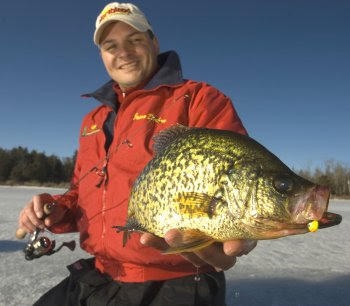 When it comes to bite detection methods for winter panfish angling, there are two schools of thought. Some believe the only option that makes sense is to use a bobber or float. Others have found that a tightlining system, with or without a spring bobber, is the best choice.
When it comes to bite detection methods for winter panfish angling, there are two schools of thought. Some believe the only option that makes sense is to use a bobber or float. Others have found that a tightlining system, with or without a spring bobber, is the best choice.
In order to make the right decision, a person has to consider several factors. These factors include temperature, bait choice, depth, time of day, and of course, personal preference.
First of all, air temperature is a key ingredient in making a presentation choice. If the angling is being done in a shelter of some kind with warm temps, slip bobber systems work very well. However, slip bobbers have a tendency to ice up when used outside on cold days which means stationary floats would work better.
When using minnows, I believe a bobber or float system is the way to go. Fish are not aggressive feeders in the winter and need time to suck in the minnow. A very light bobber will allow a finicky perch or crappie time to chew on things with little resistance.
Depth is an important consideration when making a bobber or tightlining choice. On a few lakes I fish, the panfish are found in relatively shallow water and are pretty much all at the same depth. Bobbers can work well for these situations.
Frequently, I find myself working fish that are in deep water and suspended. Tightlining is ideal for these conditions because it is very easy to watch your electronics and change depth as the fish come through. Keeping up with constantly changing depths with a bobber is nearly impossible.
I find the time of day I am fishing to be a big factor in my presentation choices. During the daylight hours, panfish are usually more lethargic than they are during the low light periods. Because of this, anglers need to do more coaxing in order to get them to bite.
Tightlining systems make it possible for anglers to jig larva bait in front of the noses of finicky panfish. Persistent jigging of one form or another will usually convince something to bite, even if they are in a very neutral mood. If the strikes are really light, a spring bobber may be needed.
Hook choices for tightlining are more critical than they are for bobber fishing. When tightlining, anglers need to select a jig that is small yet heavy enough to bounce effectively when jigged. It also needs to have enough bulk that it will read easily on your electronics. Bro’s Bug Collection from Northland is a good place to start. And I suspect the new Hexi-Fly, with its ability to reflect sonar signal, will perform ideally for tightlining.
No matter what system a person uses for winter angling, always keep it as light as the conditions will allow. If it is a bobber presentation, use the tiniest one you can. If it is tightlining, keep the jig as small as possible.
As for line, make sure it is very light. I believe this means supple, one to three-pound-test line such as Berkley Micro Ice. Four-pound test is too heavy to hang straight with light lures. If your line does not hang straight, the curls have to be pulled out before a bite can be detected.
Choosing a presentation for winter angling is often a matter of personal preference. However, sometimes the circumstances will dictate the best options for success.
Jason Durham
